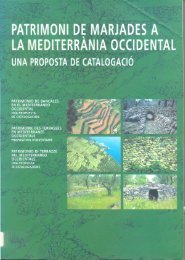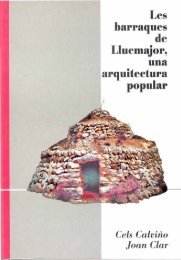La pedra en sec. Materials, eines i tècniques tradicionals a les illes ...
La pedra en sec. Materials, eines i tècniques tradicionals a les illes ...
La pedra en sec. Materials, eines i tècniques tradicionals a les illes ...
You also want an ePaper? Increase the reach of your titles
YUMPU automatically turns print PDFs into web optimized ePapers that Google loves.
*** *<br />
* * *: 6 6.5 DRYSTONE MASONRY STRUCTURES<br />
IT UCTUIITJIUUlT 0<br />
TOA RANGE<br />
OF ECONOMIC<br />
ACTIVITIES<br />
Drystone masonry was also used in<br />
activities as varied as threshing<br />
cereals and pulses, hunting birds,<br />
and making ice, charcoal and building<br />
materials (lime and plaster).<br />
Traditionally cereals and pulses<br />
were threshed and the grains separated<br />
from the chaff on a threshing floor,<br />
a circular area across which the farmer<br />
would repeatedly drive a threshing<br />
cart pulled by a mule. In terms of<br />
construction, the threshing floor<br />
would oft<strong>en</strong> be simply bordered by a<br />
stone circle to keep the grain in or<br />
additionally be mounted on top of a<br />
round terrace wall.<br />
The traditional practice of catching<br />
thrushes (Turdus spp.) with nets involved<br />
in some cases drystone masonry<br />
structures. The hunter would sit down,<br />
holding up the net, and wh<strong>en</strong> a thrush<br />
flew into it would bundle the bird up.<br />
Drystone masonry structures <strong>en</strong>abled<br />
the hunter to get higher up, and the<br />
technique was used to build stone<br />
b<strong>en</strong>ches and to place foliage that hid<br />
both the hunter and his nets.<br />
A whole range of products with differ<strong>en</strong>t<br />
uses was also produced for<br />
many c<strong>en</strong>turies using drystone<br />
masonry innovations. Ice for medicinal<br />
and cooking purposes, refer<strong>en</strong>ced<br />
since the 16th c<strong>en</strong>tury) was obtained<br />
from snow stored in reservoirs<br />
that were g<strong>en</strong>erally sited in the<br />
highest parts of the island. In order to<br />
make these reservoirs, natural<br />
depressions (av<strong>en</strong>cs) were slightly<br />
modified and dry stone masonry used<br />
to improve the structure. More commonly,<br />
a shaft was dug, drystone wal-<br />
fUa ~naoomma mm ~ roor ro~~u~<br />
aU<br />
neu or snow pits).<br />
Snow pits are large reservoirs,<br />
g<strong>en</strong>erally rectangular in shape and<br />
with rounded sides in the case of artificial<br />
ho<strong>les</strong>. The most common type of<br />
roofing usually consisted of two slopes<br />
made with a c<strong>en</strong>tral beam and a<br />
wood<strong>en</strong> frame on which crossbeams<br />
were placed. This was th<strong>en</strong> covered<br />
with ti<strong>les</strong> or reeds. All snow pits had<br />
op<strong>en</strong>ings called bombarderes which<br />
the snow came in through and an<br />
op<strong>en</strong>ing for the nevaters, or snow<br />
workers, to get inside to pack down<br />
the snow or remove the ice.<br />
Charcoal production using sitges<br />
(pi<strong>les</strong> or heaps of wood which were<br />
burnt) also gave rise to a drystone<br />
masonry structure in the woods; a circular<br />
paved area on which the sitja<br />
was built called a rotlo de sitja (charcoal<br />
bunker).<br />
Lime was produced in limekilns,<br />
round walled cavities in which limestone<br />
was calcined, and th<strong>en</strong> mostly<br />
used as mortar (boiled quicklime and<br />
sand) and lime wash. The pres<strong>en</strong>ce<br />
and amount of rough stone was to be<br />
tak<strong>en</strong> into account wh<strong>en</strong> it came to<br />
siting a limekiln in the mountains.<br />
The manufacture of all these products<br />
gave rise to particular trades<br />
carboner (charcoal maker), calciner<br />
(limekiln worker) and nevater (snow<br />
collector). These had their specific<br />
tools and organisational systems, and<br />
also a network of tracks which ran<br />
across the mountains to the work<br />
areas and linked them up with the<br />
towns and villages to give them a<br />
sa<strong>les</strong> outlet. This also involved the use<br />
of other drystone masonry structures<br />
as well, such as huts for shelter during<br />
the snow collection period or wh<strong>en</strong><br />
calcinating lime or burning wood and<br />
a number of water supply systems




